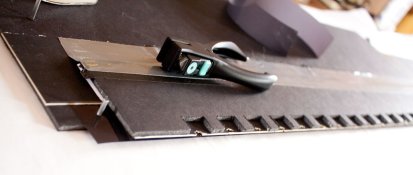I'm glad to see I'm not the only one trying this - you're even using the same punch that I am.
I've considered the microfilm route for B&W, but it does seem difficult to find. I can always slit 120 (which is another project on my list).
Old Kodak cartridges (like Kodachrome) seem too well built. I could not separate the halves without tearing the plastic where it was glued at the supply side of the cartridge. Of course, this was not a problem after applying a little electrical tape when closing it. Cheaper or off-brand cartridges seem to snap apart cleanly. I'm hoarding them right now.
Using the Kodachrome that was originally in the cartridge, I tried rolling it with the backing paper in the light, and had too much difficulty lining up the perfs in the film with those in the paper. Instead, I attached a piece of backing paper to the back of the cartridge with rubber cement (where the window is). I have to count the frames as it always shows "1."
My next experiment will be to cut a strip from the bottom edge of the backing paper, where the perfs are, so I don't have to worry about the holes. I don't think this will cause a light-leak problem, and when rolled by hand I can keep it aligned with the top edge of the film.
I purchase some of the non-perf "Portra" from
www.ultrafineonline.com, and for a proof-of-concept, punched holes using a piece of balsa wood wedged in the jaws of the punch. The wood spaced the hole from the edge, and at the "proper" distance from the punch it had a small screw sticking up. After punching a hole, I pulled the film until the hole snagged the screw, then punched another hole.
It was an incredibly tedious session to do two cartridges this way in a dark bag. I was not worried about scratches or anything, as I just wanted to see if it would work. It did.
As this was a test, I used d-76. When I get this all worked out, I will have it processed as color.
As for future perforating, I will make a small jig. Instead of using a screw to get the frame spacing, it will be a spring-loaded pin on a base, and the punch will be mounted on the same base. Rollers will keep the film off the base, and guides will keep the film positioned. Nothing fancy, just some sheet metal, a 2x4, and some homemade rollers. I'll be able to wind onto a roll while perforating.

 . The cartridges that came apart without problems were Focal and Triple Print brands. In all cases I am being extremely patient and careful.
. The cartridges that came apart without problems were Focal and Triple Print brands. In all cases I am being extremely patient and careful.
 .
.